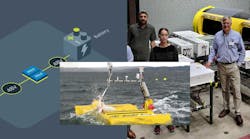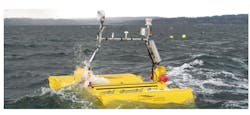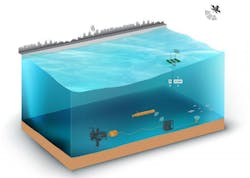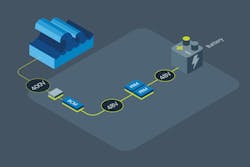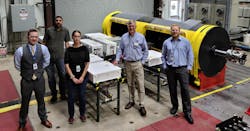Wave-Power System Aims to Create "Smart Oceans"
What you'll learn:
- How does the SeaRay AOPS platform work?
- How did C-Power overcome the problems encountered by previous wave-power harvesting systems?
- The next steps forward for SeaRay.
For close to a century, the power of ocean waves has lured inventors to their financial doom as the machines they devised to use their energy to light cities proved no match for the waves they hoped to harness. Now those dreams are being realized, albeit at a smaller scale, with a new wave energy-harvesting technology developed to power the vast fleets of ocean monitoring buoys and autonomous sensing vehicles used by many offshore industries, ocean researchers, and climatologists.
The autonomous offshore power system (AOPS) technology developed by Columbia Power Technologies Inc. (C-Power) is a kilowatt-scale generating system that will provide a cleaner, more reliable way to power the so-called "blue economy."1 In addition, the system's data and communications capabilities could help link the sensors and monitoring gear it powers to create an "Internet of the Ocean (IoO)."
The AOPS platform is based on a simple, robustly engineered, direct-drive generation mechanism. It can provide in-situ power and energy storage to power onboard payloads, networks of sensors scattered across a large area, or even act as a charging station for autonomous ocean rovers. C-Power says that its technology is scalable to support applications requiring 10 W to 1 MW.
Able to operate without fuel or service for months, or even years at a time, it promises to be a more reliable and lower-cost alternative to the existing energy sources for higher-power marine applications. Such apps include non-rechargeable onboard batteries or subsea electric tethers fed from a ship or diesel generator.
C-Power's latest version of the AOPS system, known as the SeaRAY, is an autonomous scalable platform that can be used to power applications requiring 50 W to 20 kW worth of in-situ power and energy storage. And, if needed, it provides support for real-time data and communications.
SeaRAY Enhances Power Efficiency and Data Communication
"Now that SeaRAY has been successfully deployed as part of a DARPA project called Wave Energy Buoy Systems (WEBS), the company is working to apply its technology to many other applications," said C-Power CEO Reenst Lesemann. "Our immediate plans focus on developing systems that generate 10 W to 1 MW to power offshore activities that use sensor platforms, underwater vehicles, and subsea operating equipment."
The SeaRAY system also can be equipped with a ruggedized wireless networking system that enables it to serve as a relay point for real-time data and communications for unmanned offshore activities and equipment, including subsea vehicles, sensor packages, and other operating equipment. It can use both cellular networks and satellite communications provide marine applications with a connection to the cloud (see below).
Once several systems are deployed in a region, they will create, in effect, "smart oceans" capable of supporting advanced applications within the marine economy. "These marine networks will be invaluable for aquaculture, mining, oceanographic research, military missions, and methane leak monitoring at offshore gas and oil drilling operations" said Lesemann. He noted that, in the future, scaled-up variants of SeaRAY technology might even be used to provide power for desalination systems and natural disaster recovery operations in remote areas.
Harvesting Energy from a Constantly Shifting Power Source
Succeeding in producing a wave-power system after so many others had failed required a new approach. For C-Power, this began with working on a smaller scale. While most previous projects focused on technologies intended to produce electric power for the power grid, typically hundreds to thousands of megawatts, C-Power chose to develop a scalable harvesting technology well-suited for standalone marine applications, typically requiring 1 to 100 kW.
Working at a more modest scale made it easier for them to develop a sturdy direct-drive generator capable of efficiently harnessing the random motions of the ocean environment. Their wave-energy converter uses two floats, one on each side, that roll with ocean waves. Their movements are converted to rotary motion by a power-take-off system that drives a generator. The generator's output is converted from a series of pulses into regulated dc, which is then fed to a distribution system for immediate use or stored for future use in either onboard batteries or a larger set of batteries on the seafloor.
The regulation and distribution system presented one of the other major challenges for the design team. This is mostly due to the power pulses produced by the generator, which vary wildly according to ocean conditions. The unregulated bus is unlike that of any conventional generator, with large swings in amplitude, frequency, and duration across a range that would tax the limits of most off-the-shelf conversion solutions.
While conventional linear buck regulators could do the job, they’re very inefficient and C-Power needed to save every watt-hour it could to power its customers' payloads. In addition, the necessary heatsinks would add considerable weight and consume lots of space within the buoy's electronics bay.
“We really needed wide-range dc-dc, something that we could control and regulate as we’re converting pulsed ocean wave power into a semi-stable dc bus,” said Joe Prudell, a C-Power senior R&D electrical engineer. In the end, C-Power teamed with Vicor, located in Andover, Mass., for a solution. The Vicor Power Systems design team delivered a system capable of converting power with high efficiency and charging energy-storage devices.
SeaRAY's scalable power system uses Vicor fixed-ratio bus converter modules (BCMs) and pre-regulation modules (PRMs) with complex multistage discrete converters to efficiently convert turbulent, unpredictable wave energy and provide controlled power. This enabled C-Power to increase the SeaRAY design’s conversion efficiency from about 50% to a range of 85% to 94%.
The unit also is capable of accepting external control signals from the C-Power system to match precise power-conversion needs in real-time. C-Power uses this capability to precisely adjust the power that feeds each of the SeaRAY's payloads while being fed from a widely varying input bus. In addition, the power-conversion topologies used in Vicor modules help to minimize electromagnetic interference (EMI) and noise onboard the SeaRAY that might otherwise compromise sensor measurement accuracy.
Smart Oceans Ahead
Now that SeaRAY has been successfully deployed as part of the WEBS DARPA project, the company is working to apply its technology to other applications. The National Renewable Energy Laboratory (NREL) is now partnering with C-Power to prepare a larger version of the SeaRAY AOPS for the start of its demonstration at the U.S. Navy’s Wave Energy Test Site in Hawaii this fall.2
To make sure the SeaRAY is ready for its six-month oceanic trial, NREL researchers are exposing it to a simulated ocean environment, complete with rolling wave motion, at the laboratory’s Flatirons Campus in Colorado. To simulate the motions of the ocean, NREL engineers designed an entirely new test rig—a hydraulic dynamometer—that better simulates rocking waves and currents.
C-Power CEO Reenst Lesemann is optimistic about the possibilities that the company's technology will unlock. "By combining reliable, cost-effective means of kilowatt-scale maritime energy generation and storage and high-bandwidth data services, we hope to enable the development of many new forms of offshore monitoring and communication services for a wide range of offshore activities that use underwater vehicles, subsea operating equipment, and open-ocean sensors used to collect environmental data for oceanographic research.”
Click here to learn more about SeaRAY and wave power, and click here for further information on Vicor power solutions.
References
1. Powering the Blue Economy, U.S. Department of Energy.
